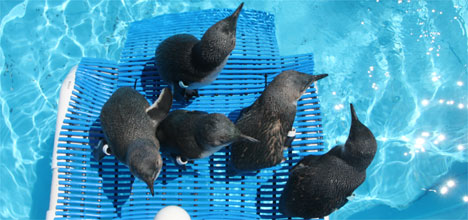It's exam time for the little blue penguins at the Te Maunga oiled wildlife centre.
Over the coming days they are going have blood samples taken as part of a veterinary thorough physical health inspection – and undergo a swimming test.
Firming a penguin's feathers for extended periods of time in the water is a major part of the swimming pool rehabilitation penguins are undertaking in Te Maunga.
The penguins coming to the end of their post oil rehab will be thrown into the swimming pools – and left to swim.
'We have the pools heavily supervised by staff,” says oiled wildlife centre manager Helen O'Connell.
'We will take away the haul-out ramps and just leave them in the pool.”
The birds need to be able to remain buoyant and waterproof for up to six hours so when the penguins return to the wild they are able to go out to sea and forage for extended periods of time.
'What happens when the birds are washed, the detergent affects the integrity of their feathers and it takes them quite a bit of time to preen and realign their feathers so that waterproofing is coming back up to standard,” says Helen.
'It can be weeks, it can be months. It depends on the individual and it depends on the environment that they are in.
'That's really important, and it's why we have created the enclosures that we have.
'The pool areas that they have got access to emulates the natural environment, and stimulates their preening because it is through their preening, that preening action that they recreate the waterproofing that they need in order to be released.
'We are just in the process of assessing that waterproofing with a lot of the birds.”
The fresh water enclosure pools and the swimming pools are also becoming saltier, to adjust the birds for the return to their natural environment.
'We're slowly adding salt into the rehab pools to build up tolerance to the salt water again,” says Helen.
'The process at the moment is assessing their water proofing and increasing the salt levels to approximate sea water so their salt glands which the birds have, aren't overwhelmed once they go back into the ocean and they can cope with that salinity change.
'Right through the rehabilitation process we are working of getting their feathers healthy again. It's just toward the end of the release that we start reintroducing them to the salt water.
'It takes somewhere in the order of four to five days to gradually increase the salt. That started in the last couple of days, they started introducing salt to the pools.”

The third criteria on the release programme is making sure the housework is done before the penguins are returned to their burrows round Mount Maunganui, Leisure Island and Rabbit Island.
'The real driving factor for us is that no birds will be released into oiled habitat,” says Helen.
'The habitat will have to be cleaned to an appropriate level and the operations team is still working on that.”
The burrows and the areas the birds move through to the sea, basically the whole coastal foreshore will have to be oil free.
'We are really dependant on habitat clean-up at this stage. We certainly don't want to be putting animals back into an environment where they can become re-contaminated.
'It would be just undoing all that hard work that we have just done, and it's putting the birds through all that additional stress.
'We are assessing all that habitat with operations teams at the moment so we can be confident that when the birds go back out, they are going into habitat that has been cleaned to a suitable standard.”
Today teams are assessing Rabbit Island and Leisure Island. The three Mount Maunganui habitats are being assessed as one area for release purposes.
Motiti Island is going to take a little longer to clean-up and the Motiti penguins are assigned their own enclosure at the Te Maunga centre.
'Motiti is probably going to be a little behind the other sites as far as clean-up,” says Helen.
'I understand there are still some areas of significant oiling out there.
'We are trying to align all those time frame targets, so there is not one thing holding them back. As soon as the habitat is ready we should be able to release.
'It's anyone's guess as to when those appropriate end points are reached at this stage.
'We are just trying to manage public expectations around the fact that it's unlikely to be in the next few days.
'We will just be assessing on a daily basis, as the clean up crews go through and clean-up the habitat is when we can actually put the animals back in the wild.”



1 comment
thankyou
Posted on 15-11-2011 13:32 | By traceybjammet
thankyou to everybody out there in the community rhat are pulling together to help the wildlife and clean the beaches etc
Leave a Comment
You must be logged in to make a comment.